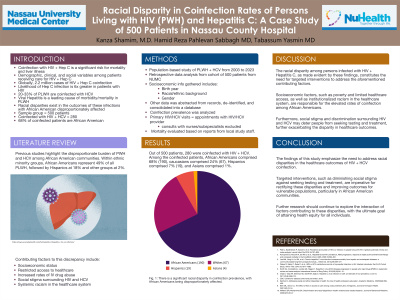Monday Poster Session
Category: Liver
P2957 - Racial Disparity in Coinfection Rates of Persons Living with HIV and Hepatitis C: A Case Study of 500 Patients in Nassau County Hospital
Monday, October 28, 2024
10:30 AM - 4:00 PM ET
Location: Exhibit Hall E

Has Audio

Kanza Shamim, MD
Nassau University Medical Center
Merrick, NY
Presenting Author(s)
Kanza Shamim, MD1, Hamid Reza Pahlevan Sabbagh, MD2, Tabassum Yasmin, MD2
1Nassau University Medical Center, Merrick, NY; 2Nassau University Medical Center, East Meadow, NY
Introduction: Infectious diseases like HIV and Hepatitis C(HCV)persist as significant public health challenges globally. Coinfection with both HIV and HCV poses a significant risk for overall mortality and liver-related illnesses. However, a considerable number of individuals with HIV-HCV coinfection go untreated for HCV. Due to common transmission pathways, it's frequent to find individuals coinfected with both HIV-HCV.
Methods: The study utilized retrospective data analysis of medical records from a cohort of 500 patients from 2013 to 2023, who underwent treatment for HIV at a tertiary care center in NY. Screening for HIV and HCV coinfection was performed and out of the 500 patients included in the study, 280 individuals were found to be HIV-HCV coinfected. For these HIV-HCV coinfected patients the socioeconomic information was gathered including the racial and ethnic background (Caucasian, Black, Hispanic, or Asian) and gender. Demographic data are abstracted from clinical records, deidentified, and consolidated into a uniform database.
Results: This study investigated the racial disparity observed in the coinfection rates of HIV-HCV coinfected patients within a sample group of 500 patients. The study found 280 individuals coinfected with both viruses, with 68% being AA . (190), white Americans were 24% (67) Hispanic were 19 (7%) and Asians were (3)1%. This finding highlights a significant racial disparity in coinfection rates, with AA individuals being disproportionately affected compared to other racial groups. Factors contributing to this disparity, included low socioeconomic status, living in zip codes with poor access to healthcare and behavioral factors including stigma of HIV and HCV.
Discussion: Previous studies have highlighted the disproportionate burden of PLWH and HCV among AA communities. As per CDC within ethnic minority groups, AA bear a disproportionate burden of HIV, representing 49% of all HIV-infected individuals. The factors contributing to this gap encompass socioeconomic status, restricted access to healthcare services, higher rates of injection drug use, stigma surrounding PLWH and HCV and structural obstacles such as systemic racism within healthcare system. These factors intersect and compound, exacerbating the vulnerability of AA populations to HIV and HCV infections while also impeding their access to receive timely diagnosis and treatment. The coinfection rates of PLWH and HCV highlights the necessity for focused interventions to tackle the root causes of this inequality.
Disclosures:
Kanza Shamim, MD1, Hamid Reza Pahlevan Sabbagh, MD2, Tabassum Yasmin, MD2. P2957 - Racial Disparity in Coinfection Rates of Persons Living with HIV and Hepatitis C: A Case Study of 500 Patients in Nassau County Hospital, ACG 2024 Annual Scientific Meeting Abstracts. Philadelphia, PA: American College of Gastroenterology.
1Nassau University Medical Center, Merrick, NY; 2Nassau University Medical Center, East Meadow, NY
Introduction: Infectious diseases like HIV and Hepatitis C(HCV)persist as significant public health challenges globally. Coinfection with both HIV and HCV poses a significant risk for overall mortality and liver-related illnesses. However, a considerable number of individuals with HIV-HCV coinfection go untreated for HCV. Due to common transmission pathways, it's frequent to find individuals coinfected with both HIV-HCV.
Methods: The study utilized retrospective data analysis of medical records from a cohort of 500 patients from 2013 to 2023, who underwent treatment for HIV at a tertiary care center in NY. Screening for HIV and HCV coinfection was performed and out of the 500 patients included in the study, 280 individuals were found to be HIV-HCV coinfected. For these HIV-HCV coinfected patients the socioeconomic information was gathered including the racial and ethnic background (Caucasian, Black, Hispanic, or Asian) and gender. Demographic data are abstracted from clinical records, deidentified, and consolidated into a uniform database.
Results: This study investigated the racial disparity observed in the coinfection rates of HIV-HCV coinfected patients within a sample group of 500 patients. The study found 280 individuals coinfected with both viruses, with 68% being AA . (190), white Americans were 24% (67) Hispanic were 19 (7%) and Asians were (3)1%. This finding highlights a significant racial disparity in coinfection rates, with AA individuals being disproportionately affected compared to other racial groups. Factors contributing to this disparity, included low socioeconomic status, living in zip codes with poor access to healthcare and behavioral factors including stigma of HIV and HCV.
Discussion: Previous studies have highlighted the disproportionate burden of PLWH and HCV among AA communities. As per CDC within ethnic minority groups, AA bear a disproportionate burden of HIV, representing 49% of all HIV-infected individuals. The factors contributing to this gap encompass socioeconomic status, restricted access to healthcare services, higher rates of injection drug use, stigma surrounding PLWH and HCV and structural obstacles such as systemic racism within healthcare system. These factors intersect and compound, exacerbating the vulnerability of AA populations to HIV and HCV infections while also impeding their access to receive timely diagnosis and treatment. The coinfection rates of PLWH and HCV highlights the necessity for focused interventions to tackle the root causes of this inequality.
Disclosures:
Kanza Shamim indicated no relevant financial relationships.
Hamid Reza Pahlevan Sabbagh indicated no relevant financial relationships.
Tabassum Yasmin indicated no relevant financial relationships.
Kanza Shamim, MD1, Hamid Reza Pahlevan Sabbagh, MD2, Tabassum Yasmin, MD2. P2957 - Racial Disparity in Coinfection Rates of Persons Living with HIV and Hepatitis C: A Case Study of 500 Patients in Nassau County Hospital, ACG 2024 Annual Scientific Meeting Abstracts. Philadelphia, PA: American College of Gastroenterology.
